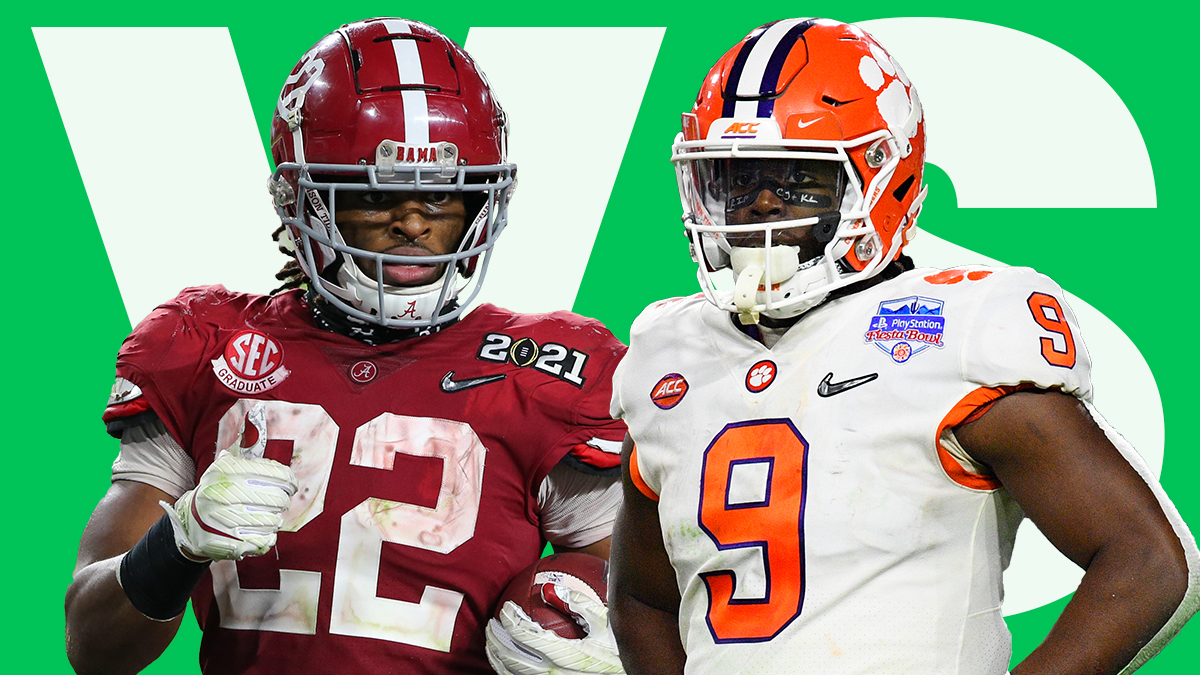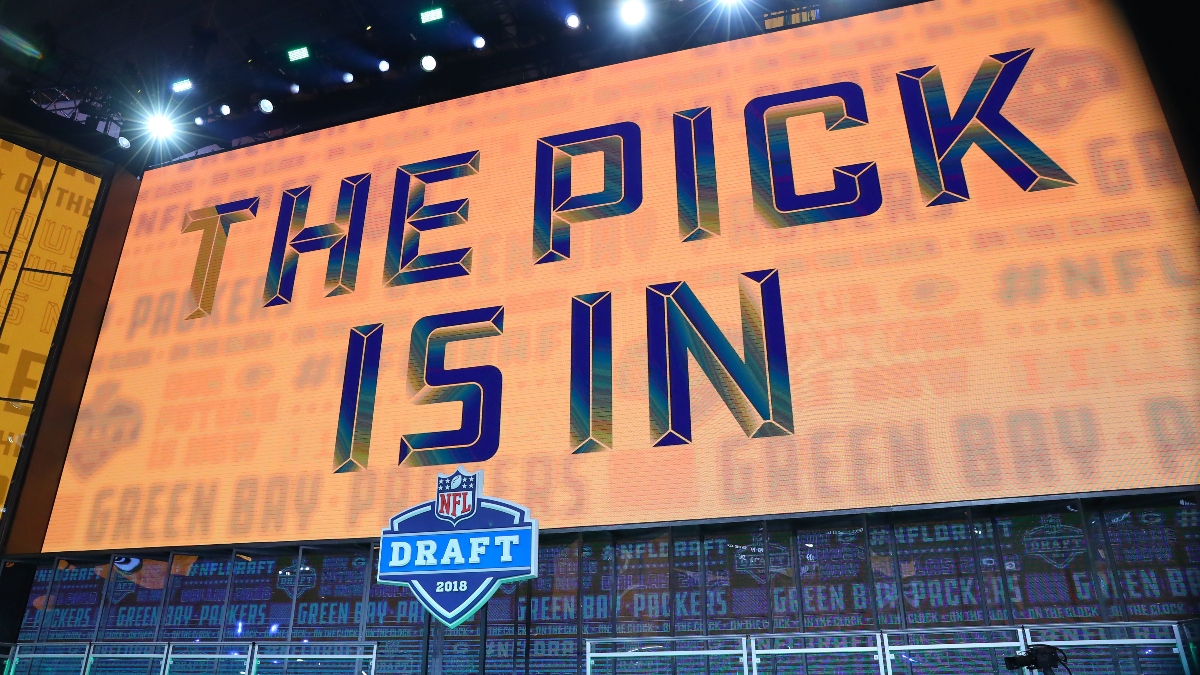Najee Harris vs. Travis Etienne: Debating Who Is the Best RB of the 2021 NFL Draft
Getty Images. Illustration by Katie Richcreek. Pictured: Najee Harris (left) and Travis Etienne (right).
Alabama vs. Clemson has become one of the best rivalries in college football in recent years, and now, there's another argument regarding which of these two teams is actually better.
Najee Harris and Travis Etienne are two of the best running backs college football has had to offer recently, and they're two of the best backs on the 2021 NFL Draft board.
But which one deserves to be taken first? Chris Raybon and Mike Ianniello debate that very topic below.
More NFL Draft Debates: Can Kyle Pitts make an immediate impact in Year 1? | Who should be the third QB drafted? | Is Ja'Marr Chase, DeVonta Smith, or Jaylen Waddle the best WR available? | Could Zach Wilson be considered the No. 1 QB?
The Case for Travis Etienne

I think Najee Harris is going to have a fantastic pro career. I think he has obvious Pro Bowl potential. But Travis Etienne has a skill set more valuable in today’s NFL, and Harris being ranked ahead of him shows a bit of recency bias.
Etienne had a down year in 2020 by his standards. His 5.4 yards per carry and 7.0 yards from scrimmage were the lowest of his career. A large reason for that, though, was the lack of experience on the offensive line in front of him. Clemson had to replace four of its five starters from the 2019 team.
The Clemson offensive line ranked 51st in the country in Line Yards and 36th in Stuff Rate. Also, the “down year” for Etienne was still good enough for the 17th-most rushing yards and seventh-most rushing touchdowns in college football.
Harris had the benefit of rushing behind an offensive line that took home the Joe Moore Award for the best collegiate offensive line unit. He posted 5.8 yards per carry, just slightly ahead of Etienne.
Let’s do a quick little blind exercise. Player 1 averaged 6.2 yards per carry in college and 12.2 yards per reception during their college career. Player 2 had 5.7 yards per carry and 11.7 per reception. Player 3 posted 6.2 per carry and 9.2 per reception. And Player 4 averaged 7.2 per carry and 11.3 per receptions.
Player 1 is Christian McCaffery, Player 2 is Saquon Barkley, Player 3 is Alvin Kamara, and Player 4 is Travis Etienne. Those are three of the five best running backs in the NFL, in part because of their ability to catch the ball out of the backfield.
The more pass happy the NFL becomes, the more important it is to have a pass-catching weapon at running back. Etienne had similar pass catching numbers in college to all of those three All-Pro running backs but also showed to be a better rusher between the tackles.
Etienne’s ability to catch passes out of the backfield is what makes him the most valuable running back in this draft. Despite a less efficient year running the ball, he had his best season receiving out of the backfield, catching 48 passes for 588 yards on 12.3 yards per catch.
Najee Harris might be a bit better between the tackles, but Etienne has the edge as the better all-around back. Harris averaged 6.4 yards from scrimmage with 57 total touchdowns in his four years at Alabama. Etienne averaged 7.8 yards from scrimmage and racked up 78 total scores in his four seasons at Clemson.
Photo Credit: Tom Pennington/Getty Images.
The Case for Najee Harris
By Chris Raybon

I think Etienne’s edge as a receiver is overstated at this point.
Last season, Harris caught 43 passes and forced 22 missed tackles in the receiving game — nine more than any other back in the nation, including Etienne, who had 13 on 48 catches. And in Harris’ career, he has dropped only 3-of-83 catchable passes (3.6%), while Etienne has let 10-of-112 (8.9%) catchable balls hit the ground.
Degree of difficulty gets brought up as an argument for Etienne over Harris after their diverging performances in 2020, but I view Etienne’s dip in performance as a senior as a red flag given his slight stature (5-foot-9, 205 pounds) and the fact that it came after logging 577 touches in Years 1-3.
Running backs have a short shelf life, so call it decency bias if you want, but I do want the one who is playing better more recently and has proven able to sustain elite performance over a longer span.
And regardless of per-carry or per-touch yardage figures, there's arguably no more translatable skill than making people miss, and Harris forced 93 missed tackles on 295 touches (31.5%) last year while Etienne forced 57 on 214 (26.6%).
At 230 pounds, Harris projects as the more durable player, and with no concern about a drop-off in his most recent play, I think he profiles as the higher-floor, higher-ceiling back.
Photo Credit: UA Athletics/Collegiate Images/Getty Images.
Etienne Rebuttal
Ianniello: While Raybon thinks Etienne’s edge as a receiver is overstated, I think Harris’s edge as the better rusher is overstated.
Etienne is much faster than Harris. He ran a 4.41 40-yard dash, and his high-end speed and long strides make him a constant home run threat. He had 19 plays from scrimmage of 20+ yards last season, fourth-most for a running back, and at least 22 in each of the previous two seasons. Harris had just 25 in his four-year career.
Etienne played most of his Clemson career at 205 pounds. but has bulked up 215. He isn’t just a speedster but is deceptively powerful. In his Clemson career, he racked up 3,087 yards after contact, 400 more yards after contact than any other player in this year’s draft.
Etienne has an elite ability to find the end zone and is the FBS record-holder for most career games with a touchdown, scoring in 46 of his 55 college games. He is one of only 12 players in CFB history to accumulate 4,000 career rushing yards and 1,000 career receiving yards.
Harris Rebuttal
Raybon: I’m not sure the bulking up is necessarily a good thing because it again brings up questions about consistency and risk.
Etienne has been wanting to gain weight since 2019, but he doesn’t, and we see a drop-off in his play last year. Then, he gained weight ahead of his Pro Day, and analysts who saw his pro day thought he was too bulky and questioned his ability to make defenders miss at the next level at that weight.
Is there a happy medium?
Perhaps, but the point is we don’t know, and that creates risk. And if he plays at his bulked-up weight, it’s not just that we have questions that come with whether or not he can maintain what made him special at Clemson, it’s that we haven’t seen him play at this weight, period.
Etienne has more question marks attached and was not the better back in 2020. That’s enough to solidify Harris in the top spot for me.
Final Thoughts for Etienne
Ianniello: When you look at where the first running back could come off the board at this year’s draft, the first spot that jumps out is the Pittsburgh Steelers at pick No. 24.
Etienne reminds me a lot of Le’Veon Bell, and I think Etienne would be the perfect running back to shine in that offense the way Bell did. Bell was a little bigger, but Etienne is much quicker and more elusive in open space.
Bell was a first-round selection after averaging 5.0 yards per carry and 6.8 yards per reception during his three years at Michigan State. Bell went on to have 5,336 yards rushing, 2,660 yards receiving and 42 total touchdowns in his five seasons in Pittsburgh.
Etienne has the perfect dual-threat ability to thrive in today’s NFL, and I expect him to be the best running back in this class.
Final Thoughts for Harris
Raybon: The argument for Etienne has always been dual-threat ability, perhaps because of the difference in sizes between the two backs. But Harris needs no qualifier; he simply has better ability.
He's always been the better inside runner, and when given the chance to catch the ball at the same volume as Etienne, he also proved to be superior at making defenders miss in space.
Harris has not only dual-threat ability but sustainability, as proven by his more consistent high level of play throughout his entire collegiate career.
And let's not forget: It was Etienne himself who questioned his own durability if he continues to play at the same weight he was at Clemson, and especially at running back, the NFL is a game of attrition where the best ability is availability.
Harris should be the pick because I believe he has all the ability of Etienne, if not more, and will be able to sustain a higher number of total touches over the course of a season and career.
How would you rate this article?








